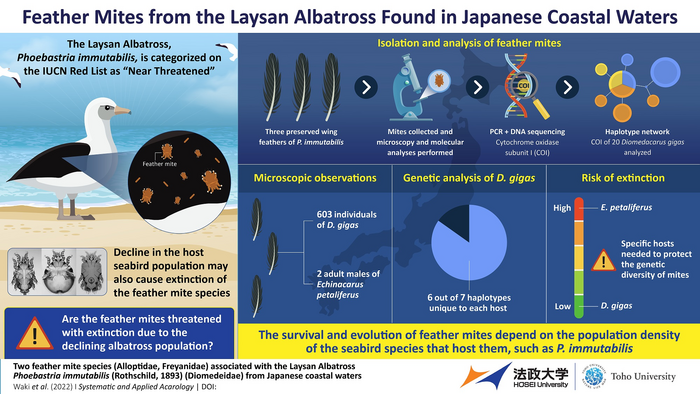Phoebastria immutabilis, commonly known as the Laysan Albatross, is a large seabird native to the North Pacific Ocean. Owing to the decrease in their population size, this species has been listed as “Near Threatened” in the Red List of the International Union for Conservation of Nature. Laysan Albatrosses, like other birds, have a symbiotic relationship with feather mites, a species of highly host-specific parasites that inhabit the feathers of the birds.

Credit: Tsukasa Waki from Toho University, Japan.
Phoebastria immutabilis, commonly known as the Laysan Albatross, is a large seabird native to the North Pacific Ocean. Owing to the decrease in their population size, this species has been listed as “Near Threatened” in the Red List of the International Union for Conservation of Nature. Laysan Albatrosses, like other birds, have a symbiotic relationship with feather mites, a species of highly host-specific parasites that inhabit the feathers of the birds.
Now, with the threat of extinction looming over P. immutabilis, the feather mites could be in danger, too. Changes in the population dynamics of either host or their symbiont (the organism living in symbiosis with the host) can lead to an ecological imbalance. However, their current population and infection status remains ambiguous in Japan. To bridge this gap, Professor Satoshi Shimano from Hosei University, along with Associate Professor Tsukasa Waki from Toho University and Professor Masaki Eda from Hokkaido University, all in Japan, investigated the current status of P. Immutabilis feather mites. They studied bird specimens from in and around Japanese coastal waters. Their recent work was published in Volume 28, Issue 1 of the journal Systematic and Applied Acarology on 19 January 2023.
Sharing the motivation behind their investigation, Prof. Shimano states, “The feather mite Compressalges nipponiae, which infects the Crested Ibis, is known to have become extinct with the disappearance of its host population in Japan. Therefore, information on the mite symbionts, thought to clean the host’s feathers, could be helpful in conserving the Layasan Albatross.” Their study and findings were published in the journal Systematic and Applied Acarology.
Feather mites from three preserved P. immutabilis wing feathers were studied using microscopy and molecular analyses. The team identified 603 members of Diomedacarus gigas, and two adult males of Echinacarus petaliferus. Remarkably, this is the first study to report on the occurrence of D. gigas in Japan in the last 50 years, and the first-ever on E. petaliferus. The team provided a detailed morphological redescription of the isolated mites. Twenty D. giga and one E. petraliferus mites were selected for analysis of haplotype network – a method to determine genetic diversity and lineage.
Every organism has a unique set of genes that do not undergo much variation over time, which makes them a molecular fingerprint. Cytochrome Oxidase Subunit I (COI) was used as the target gene for haplotype analysis of D. gigas. The COI parsimony network revealed seven different haplotypes, of which six were unique to their hosts. The large proportion of unique COI haplotypes pointed to a greater genetic diversity and stable population of D. gigas. On the other hand, genetic information could not be obtained for E. petaliferus and additional research is expected for this species. The team concluded that E. petaliferus was a rare species in Japan, with a high risk of extinction.
In summary, these findings highlight the strong correlation between the ecology of the mites and the population of P. immutabilis. Foreseeing possible future avenues for their work, Dr. Waki speculates, “We believe that the information on the Laysan Albatross and the distribution of its symbionts will enable better conservation planning and extinction risk assessment for this species. This knowledge will ultimately lead to a better preservation of ecosystems for future generations.”
And we certainly hope his visions come true!
***
Reference
Authors: Tsukasa Waki1, Masaki Eda2, and Satoshi Shimano3
Title of original paper: Two feather mite species (Alloptidae, Freyanidae) associated with the Laysan Albatross Phoebastria immutabilis (Rothschild, 1893) (Diomedeidae) from Japanese coastal water
Journal: Systematic and Applied Acarology
Abstract URL: https://www.biotaxa.org/saa/article/view/74995
Article URL: http://zoobank.org/urn:lsid:zoobank.org:pub:C2AC09A5-E630-4863-B9F6-011006832E38
Affiliations:
1Faculty of Science, Toho University
2Hokkaido University Museum, Hokkaido University
3Science Research Center, Hosei University
About Professor Satoshi Shimano
Satoshi Shimano is an acarologist and a Professor at the Science Research Center at Hosei University in Japan. He obtained his master’s degree from Nagoya University and his doctoral degree from Yokohama National University, both in Japan. His research interests include systematics, taxonomy, soil zoology, acarology, and protistology. He has published 177 papers with over 1800 citations to his credit. Additionally, he is a recipient of several awards and has a patent to his name.
About Associate Professor Tsukasa Waki
Tsukasa Waki is an Associate Professor at the Faculty of Science at Toho University, Japan. He earned his PhD from The University of Tokyo, and is currently pursuing research across field ecology, population ecology, pathogens and virulence, infection, and mortality. He has published 55 articles on diverse topics in the biological sciences since 2009.
About Hosei University
Hosei University is one of the leading private universities in Tokyo, Japan. The university offers international courses in many disciplines and has a long and rich history. Hosei University was founded as a school of Law in 1880 and evolved into a private university by 1920.
It is also home to multiple research centers, which conduct advanced research on various fields, including nanotechnology, sustainability, ecology, and more.
The university has three main campuses—Ichigaya, Koganei, and Tama, located across Tokyo.
Journal
Systematic and Applied Acarology
DOI
10.11158/saa.28.1.7
Method of Research
Experimental study
Subject of Research
Animals
Article Title
Two feather mite species (Alloptidae, Freyanidae) associated with the Laysan Albatross Phoebastria immutabilis (Rothschild, 1893) (Diomedeidae) from Japanese coastal waters
Article Publication Date
19-Jan-2023



